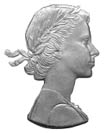
Mary Gillick
Encyclopedia
Mary Gillick was a sculptor best known for her effigy
of Elizabeth II
used on coinage in the United Kingdom
and elsewhere from 1953 to 1967.
 Born Mary Tutin in Nottingham
Born Mary Tutin in Nottingham
, she was educated at the Nottingham School of Art
and at the Royal College of Art
from 1902 to 1904. After making her first exhibition at the Royal Academy
in 1911, she designed several medal
s to be used as awards, and several other, larger relief sculptures in stone
and bronze
.
In 1952, Gillick's effigy design was selected from a field of seventeen to be used on general-circulation coinage for the new Queen Elizabeth, first issued in 1953.
Gillick's design was notable for portraying the Queen uncrowned, and was the last to be used on the pre-decimal coinage. It is still used for Maundy money
and various commemorative issues.
Gillick's die master had insufficient relief, and the striking was too weak. Facial features and the dress folds in the shoulder disappeared. The problem was solved by re-cutting the dies. This remastering was performed by Cecil Thomas, an experienced medallist who had already crafted overseas currencies featuring Elizabeth II, but who had initially been turned down for the British coinage in preference to Gillick.
A cameo of Gillick's effigy of the Queen has been used on British commemorative stamps since 1966.
She was married (1905) to another noteworthy sculptor, Ernest Gillick
, who is believed to have influenced her work.
Effigy
An effigy is a representation of a person, especially in the form of sculpture or some other three-dimensional form.The term is usually associated with full-length figures of a deceased person depicted in stone or wood on church monuments. These most often lie supine with hands together in prayer,...
of Elizabeth II
Elizabeth II of the United Kingdom
Elizabeth II is the constitutional monarch of 16 sovereign states known as the Commonwealth realms: the United Kingdom, Canada, Australia, New Zealand, Jamaica, Barbados, the Bahamas, Grenada, Papua New Guinea, the Solomon Islands, Tuvalu, Saint Lucia, Saint Vincent and the Grenadines, Belize,...
used on coinage in the United Kingdom
United Kingdom
The United Kingdom of Great Britain and Northern IrelandIn the United Kingdom and Dependencies, other languages have been officially recognised as legitimate autochthonous languages under the European Charter for Regional or Minority Languages...
and elsewhere from 1953 to 1967.

Nottingham
Nottingham is a city and unitary authority in the East Midlands of England. It is located in the ceremonial county of Nottinghamshire and represents one of eight members of the English Core Cities Group...
, she was educated at the Nottingham School of Art
Nottingham Trent University, School of Art and Design
Founded in 1843, the School of Art and Design at Nottingham Trent University is one of the oldest in the United Kingdom and currently has more than 2,500 students.-History:...
and at the Royal College of Art
Royal College of Art
The Royal College of Art is an art school located in London, United Kingdom. It is the world’s only wholly postgraduate university of art and design, offering the degrees of Master of Arts , Master of Philosophy and Doctor of Philosophy...
from 1902 to 1904. After making her first exhibition at the Royal Academy
Royal Academy
The Royal Academy of Arts is an art institution based in Burlington House on Piccadilly, London. The Royal Academy of Arts has a unique position in being an independent, privately funded institution led by eminent artists and architects whose purpose is to promote the creation, enjoyment and...
in 1911, she designed several medal
Medal
A medal, or medallion, is generally a circular object that has been sculpted, molded, cast, struck, stamped, or some way rendered with an insignia, portrait, or other artistic rendering. A medal may be awarded to a person or organization as a form of recognition for athletic, military, scientific,...
s to be used as awards, and several other, larger relief sculptures in stone
Rock (geology)
In geology, rock or stone is a naturally occurring solid aggregate of minerals and/or mineraloids.The Earth's outer solid layer, the lithosphere, is made of rock. In general rocks are of three types, namely, igneous, sedimentary, and metamorphic...
and bronze
Bronze
Bronze is a metal alloy consisting primarily of copper, usually with tin as the main additive. It is hard and brittle, and it was particularly significant in antiquity, so much so that the Bronze Age was named after the metal...
.
In 1952, Gillick's effigy design was selected from a field of seventeen to be used on general-circulation coinage for the new Queen Elizabeth, first issued in 1953.
Gillick's design was notable for portraying the Queen uncrowned, and was the last to be used on the pre-decimal coinage. It is still used for Maundy money
Maundy money
Royal Maundy is a religious service in the Church of England held on Maundy Thursday, the day before Good Friday. At the service, the British Monarch or a royal official ceremonially distributes small silver coins known as "Maundy money" as symbolic alms to elderly recipients...
and various commemorative issues.
Gillick's die master had insufficient relief, and the striking was too weak. Facial features and the dress folds in the shoulder disappeared. The problem was solved by re-cutting the dies. This remastering was performed by Cecil Thomas, an experienced medallist who had already crafted overseas currencies featuring Elizabeth II, but who had initially been turned down for the British coinage in preference to Gillick.
A cameo of Gillick's effigy of the Queen has been used on British commemorative stamps since 1966.
She was married (1905) to another noteworthy sculptor, Ernest Gillick
Ernest Gillick
Ernest Gillick was a British sculptor.Gillick studied at the Nottingham School of Art and the Royal College of Art in London. His first important commission was for the figures of J.M.W...
, who is believed to have influenced her work.

